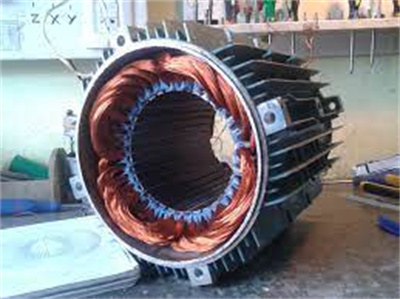
Characteristics for SWG 10 Motor Winding Wire
SWG 10 motor winding wire is a thick-gauge, high-conductivity 3.251mm copper conductor. It is protected by a durable, high-temperature insulating film, commonly known as enamel. This article will introduce the characteristics for SWG 10 motor winding wire.

SWG stands for Standard Wire Gauge. The key point is that the SWG number is inversely proportional to the wire diameter. The smaller the number, the thicker the wire; the larger the number, the thinner the wire.
Therefore, SWG 10 represents a winding wire that is a thicker gauge in the SWG standard.
| Property | Value |
| Diameter | 3.251 mm(approximately 0.1280 inch) |
| Cross-sectional area | 8.30 mm² |
| Conductor material | Copper |
| DC Resistance | 6.81 (Ohm/km) |
| Approx. Current Capacity) | 16.6 A – 32.8 A |
Applications
Due to its thicker wire diameter and higher current-carrying capacity, SWG 10 is often used in high-power electrical equipment:
Medium to large industrial motors: Main windings in pumps, fans, air compressors, and transmission equipment.
Generator field windings: Rotor windings that carry high excitation currents.
Power transformers: Used on the low-voltage, high-current winding side.
Conductor Material
Most high-performance SWG 10 motor winding wire uses pure copper as the conductor material.
Copper’s advantages: Excellent conductivity, good ductility, and mechanical strength make it the preferred material for motor windings.
Current Capacity
The maximum current carrying capacity of SWG 10 copper wire is typically between 35 and 55 amperes (A), depending on factors such as insulation type, ambient temperature, and heat dissipation conditions.
SWG 10 Winding Wire Insulation: Thermal Rating is Key
Motor winding wire must have a high-quality insulation coating to prevent short circuits between windings and between the windings and the motor core. The choice of winding wire insulation directly determines the motor’s thermal rating and service life.
Common SWG 10 winding wire insulation types include:
| Insulation type | Commonly used materials | Typical heat resistance grades | description |
| Polyester/polyesterimide | Modified Polyester, Polyesterimide (EIW) | 155°C (F class), 180°C (H class) | It has good mechanical and thermal properties and is widely used. |
| Polyesterimide/Polyamideimide | PEI/PAI (Dual Coated) | 200°C – 220°C (H+ Grade, K Grade) | High-performance option. Excellent resistance to thermal shock, solvents, and abrasion. Commonly used in motors used in demanding and harsh environments, such as submersible pump motors. |
| BOPP film | Biaxially Oriented Polypropylene Film | 150°C – 200°C | Commonly found in some submersible motor winding wires, it provides good dielectric strength. |
How to Choose High-Quality SWG 10 Motor Winding Wire?
Choosing the right SWG 10 winding wire ensures motor life and efficiency. Consider the following:
Confirm the standard: Ensure the product complies with international or industry standards, such as IS 8783 or the IEC 60317 series.
Measure the diameter: Use a high-precision gauge (such as a micrometer) to measure the diameter of the bare copper conductor to ensure it meets SWG 10 specifications, especially for applications with tighter wire diameters, such as submersible pumps.
Inspect the insulation:
Insulation Thickness: High-quality wire has uniform insulation thickness and is free of bubbles.
Thermal Class: Select the appropriate thermal class (e.g., Class F or Class H+) based on the motor’s operating environment and design temperature.
Flexibility and Tensile Strength: High-quality winding wire should be flexible enough to prevent cracking or damage to the insulation during the high-stress winding process.
